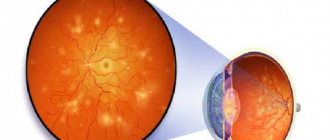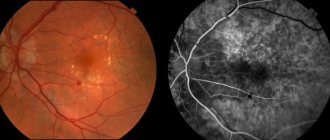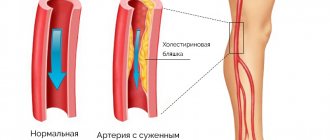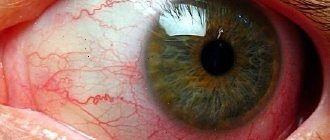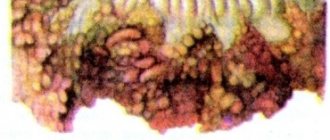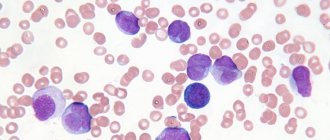Retinal angiopathy is a dangerous disease in which changes occur in the blood vessels, as well as disorders in nervous regulation. It always progresses against the background of other diseases and can lead to retinal dystrophy and complete blindness. It is necessary to treat retinal angiopathy, and first of all you need to find out the reasons that led to the disease. With timely diagnosis and treatment, the pathology can be completely cured, so when the first signs or pain appear, you should run to an ophthalmologist for diagnosis.
Treatment is usually conservative, but in severe cases laser therapy is used. In this article we will talk about retinal angiopathy, its causes, diagnosis, treatment methods and prevention.
Retinal angiopathy - what is it?
The term “angiopathy” consists of two words: “angio” - vessel and “pathy” - disease. With angiopathy, for some reason the normal functioning of its vessels is disrupted. In this case, the retina does not receive enough blood supply due to impaired function of the fundus vessels.
Angiopathy is not an independent diagnosis, but a consequence of other pathologies.
With retinal angiopathy, the blood supply to the arteries and veins of the posterior wall of the eyeball changes, which leads to progressive visual impairment.
Causes
Any angiopathy appears as a result of any long-term malfunction in the body. Most often, this pathology is observed in patients whose health is impaired due to:
- pressure disorders (arterial hypertension, dystonia or hypotension);
- increased intracranial pressure of various origins (congenital pathology, in old age, due to diseases);
- systemic vasculitis;
- juvenile angiopathy (Eales disease);
- diabetes mellitus;
- vascular atherosclerosis;
- arteritis (usually in the head area);
- glaucoma;
- injuries (usually head, neck, face);
- perinatal pathology (injuries or anomalies in newborns);
- infectious brain lesions (including congenital);
- general intoxication (for external or internal reasons);
- thrombosis;
- serious nervous shocks;
- work in hazardous industries;
- radiation damage;
- smoking;
- high degree scoliosis;
- aged over 70 years.
Kinds
Usually the patient is given a diagnosis indicating the type of angiopathy. The type of illness indicates the disease that caused the appearance of this eye pathology.
There are types of retinal angiopathy:
- traumatic;
- diabetic;
- hypertensive;
- hypotonic;
- youthful.
Symptoms of the disease
Source: okodent.ru
It should be noted that the patient may not present any complaints for a long time and not notice deterioration in vision. This is a reversible disease, but only in the initial stages and in cases where the root cause can be accurately determined.
Retinal angiopathy, as a rule, is not an independent disease; it is a consequence of other pathologies in which vascular damage occurs. These may include hypertension, atherosclerosis, diabetes mellitus and other diseases.
In most cases, angiopathy occurs simultaneously in both eyes. The disease can occur in people of any age, but is more common after 30 years of age.
The main symptom of the disease - damage to the retinal vessels - can be seen during hardware examination. This may be a narrowing or dilatation of the blood vessels of the eyes, minor hemorrhages. Here are some symptoms:
- Blurred vision, flashing dots before the eyes;
- Discomfort and pain in the eyes;
- Bloody discharge in the urine;
- Pain in the joints, pain in the legs when walking;
- Nosebleeds;
Often, patients at the initial stage of the disease may not even pay attention to it, explaining the symptoms as simple overwork. They think that if the retina is damaged, it will go away on its own soon.
In the modern rhythm, many people work on computers and therefore are forced to subject their eyes to increased stress. In this case, it is precisely necessary to check the eyes as often as possible so as not to miss important signs that may indicate the development of a serious and complex pathology.
Gradually, the symptoms increase and become much more obvious. Symptoms appear more clearly after work that requires concentration and strain on the eyes.
In later stages, serious visual impairment occurs, which gradually leads to its complete loss.
Usually the disease does not progress too quickly and therefore it is quite possible to seek help from a doctor. Deteriorating vision is already a sufficient reason to go to the hospital.
Manifestations of the disease
The main danger of retinal angiopathy lies in its asymptomatic course.
Often, retinal angiopathy is accidentally detected during a fundus examination by an ophthalmologist. When the symptoms of angiopathy become clearly visible, then this stage of the disease already requires long-term and expensive treatment.
When is it absolutely necessary to see a doctor?
This must be done immediately if a person suddenly begins to notice changes in himself in the form of:
- A sharp decrease in vision. In this case, the patient touches distant objects or is unable to read small print.
- Frequent redness of the eyes with streaks of burst blood vessels.
- The appearance of “floaters” or veils before the eyes.
- Narrowing of the visual field and peripheral vision. In this case, the patient may have difficulty seeing what is happening to the side of him: a leaving car, an approaching person, etc.
- Feelings of pulsation in the eyes.
- Frequent eye pain with minimal exertion (working at a computer, short reading or needlework).
The first symptoms of angiopathy are rarely taken into account, so the disease develops further.
The most common symptoms of this disease in the mature stage are:
- decreased visual acuity and clarity;
- deterioration or loss of color sensitivity;
- narrowing of the field of vision or blurring of it;
- the appearance of lightning, dots or white lines before the eyes.
In systemic diseases, retinal angiopathy is a consequence of the general fragility of blood vessels in the body. In this case, the patient may have minor bleeding or hemorrhages (skin, nasal, streaks of blood in the stool, etc.)
Degrees of angiopathy in hypertension
In hypertension, angiopathy is associated with overflow of the bloodstream. Depending on the severity of symptoms, the disease in hypertensive patients can have different severity: 1, 2 or 3 degrees. With hypertension, the vessels of the fundus dilate and twist, and small hemorrhages form in the ophthalmic veins. Subsequently, the retina becomes cloudy, and hemorrhages become a constant companion for hypertensive patients.
1st degree
This is the stage when the disease process is still reversible. If you begin to seriously fight the underlying disease, then changes in the eyes will be able to be eliminated.
Retinal angiopathy in the initial stage is characterized by ophthalmological disorders such as:
- varicose veins;
- narrowing of the arteries;
- increased tortuosity of blood vessels;
- discrepancies between the width of the vessels and their length.
2nd degree (moderate)
This stage occurs if there was no timely treatment at the onset of the disease. At this stage, there are already organic changes in blood vessels.
The second stage is characterized by manifestations:
- increasing discrepancies in the size of blood vessels and their tortuosity;
- narrowing of blood vessels with deterioration of blood circulation through them;
- phenomena of thrombosis and vascular hemorrhage;
- the appearance of microaneurysms and growths in the area of the optic nerve;
- narrowing of the field of view and blurring of it;
- decreased visual acuity and the appearance of myopia.
3rd degree
At this degree, organic vascular damage is maximally expressed, and vision deterioration can reach complete blindness.
Stage 3 angiopathy is characterized by symptoms:
- swelling of the retina and optic nerve:
- hemorrhages in the retina;
- white lesions:
- severe impairment of visual acuity and blurred vision (up to loss).
Stages of development
Retinal angiosclerosis is a rather dangerous disease that can lead to the development of serious complications. Keep in mind that the disease often occurs against the background of high blood pressure. At the moment, doctors distinguish 4 stages of development of this disease, among them:
- Hypertensive angiopathy is the initial stage that needs to be stopped. If you can start full-fledged treatment in a timely manner, the likelihood of negative consequences will be extremely low. The blood vessels gradually thicken, their lumen decreases significantly;
- Hypertensive angiosclerosis of the retina. Blood vessels continue to lose their elasticity, and their heterogeneity appears;
- Hypertensive angioretinopathy is a condition in which focal opacities occur. A person's field of vision is significantly narrowed, and his visual acuity decreases. There is a possibility of hemorrhage into the retina;
- Hypertensive neuroretinopathy - at this stage, the degenerative process affects the optic nerve. Spider veins can be seen on the retina itself.
Types of illness
After visiting a specialist, not only the diagnosis is established, but also the type of angiopathy. Among the types of this disease there are types of angiopathy:
- hypertensive;
- hypotonic;
- mixed;
- dystonic;
- diabetic;
- background;
- venous;
- traumatic.
Let's consider the features of each type of these types of angiopathy.
Hypertensive type
Occurs with prolonged hypertension and is caused by blood-filled vessels. This leads to degenerative changes in the retinal vascular bundle. In this case, visual acuity often decreases and a feeling of fogginess occurs. The condition may worsen if hypertension continues to progress.
Hypotonic type
Occurs due to decreased vascular tone and stagnation of blood in the vessels. Such stagnation causes thrombosis of the capillaries. In this case, hemorrhages appear in the eyeball and retina. Vision is seriously affected by these changes.
Mixed type
Caused by disturbances in vascular regulation by the autonomic nervous system. This pathology is preceded by any systemic ailments that affect the vascular network of the body. And the capillaries of the eye fundus suffer first of all.
Although systemic diseases can occur at any age, the mixed form is more common in patients over 30 years of age. Such pathologies can lead to serious deterioration or loss of vision. The main manifestations of vascular disorder are manifestations of “flares”, blurring or pain in the eyes, and hemorrhages in the retina.
Treatment of mixed type angiopathy is closely related to the improvement of blood circulation throughout the body. Comprehensive treatment of the underlying disease can improve the condition of the eyes.
Diabetic
Occurs in diabetics. Lack of insulin in diabetes causes disturbances in glucose metabolism. However, the disease does not end there: if the insulin hormone is insufficient, disturbances in all metabolic processes (carbohydrate, protein, fat, mineral) occur in the body.
In diabetes, blood vessels throughout the body are narrowed and affected, starting with capillaries and ending with large main vessels. At the same time, blood flows slower and blood vessels become clogged. Lack of blood circulation creates problems in the tissues, depriving them of normal nutrition. In this case, the eyes are among the first to be affected, manifesting themselves in a high degree of myopia or even blindness.
Background angiopathy
Appears against the background of other diseases. With this type of angiopathy, dystrophy processes develop in the retina. This type of pathology is a consequence of a number of diseases or conditions: vascular diseases, blood diseases, autoimmune vasculitis, traumatic lesions of the neck or head, intoxication, diabetes mellitus, hypertension, high intracranial pressure, work with constant visual tension.
With background angiopathy, changes in the vascular walls disrupt their functioning. Persistent eye dysfunction leads to irreversible visual impairment, including loss of vision.
Venous
It occurs as a complication of pathologies associated with impaired blood flow. In this case, the blood flows more slowly and forms stagnations, which leads to the formation of blood clots or hemorrhages in the eyeball. The veins then become tortuous and dilated throughout. Often such a violation occurs in “experienced” hypertensive patients.
Venous angiopathy can lead to multiple disorders such as blurred vision or progressive myopia. Improvement in this disease is closely related to the treatment of the underlying disease.
Traumatic
It happens that the most minor injuries lead to a sharp deterioration or loss of vision. This often results from injuries to the neck, brain, and compression of the chest. Swelling after contusions, for example, leads to retinal opacities.
With traumatic angiopathy, the vessels of the cervical spine are compressed, while the ocular vessels are narrowed. As a result, intracranial pressure increases, which with this type of angiopathy can be consistently high. The tone of the retinal vessels suffers from this, which is expressed by constantly worsening visual disturbances, manifested by increasing myopia.
The mechanism of complications in traumatic angiopathy is due to the fact that sudden compression of blood vessels during injury also spasms the blood vessels of the eyes, which causes hypoxia of the retina with the release of fluid from it. Subsequently, the injury leads to organic changes in the retina and hemorrhages in it. This disease also affects the optic nerve, which leads to severe deterioration or loss of vision.
In newborns
This is a special type of angiopathy, which is often considered as a normal variant. Often this diagnosis is made at the birth of the baby. But sometimes angiopathy in babies can be a harbinger of congenital neurological problems.
Often, angiopathy in infants occurs after head injuries due to difficult childbirth. In this case, redness of the eyes and the appearance of spider veins are noticeable. Usually these symptoms pass quickly.
However, consultation with a neurologist for neonatal angiopathy is mandatory in any case.
The retina of babies reacts very quickly to various stresses (emotional, physical), and changes in body position. At the same time, specialists should be alert to the phenomena of any venous congestion or vasoconstriction in the eyes of children.
Often, retinal angiopathy indicates some existing pathology in the baby. Its identification and proper treatment leads to a reduction in pathological changes in the blood vessels of the eyes.
Provoking factors
In addition to the causes that lead to angiopathy, it is known about the factors that provoke and aggravate the course of the disease. Often the following factors can serve as such “push” factors:
- smoking;
- elderly;
- chronic intoxication (including alcohol);
- hematological diseases with a tendency to blood clots;
- diseases with severe disturbances of neurovascular regulation (due to osteochondrosis, increased cranial pressure, head injuries);
- anatomical features of arteries.
Why is retinal angiopathy dangerous?
Angiopathy is also called a “time bomb” in the body. Impaired vascular functions can lead to dystrophic changes in the retina. In addition to deterioration of vision or myopia, the pathological process can lead to its complete loss.
If you do not take retinal angiopathy seriously, it can after some time lead to serious disorders in the form of:
- progressive visual impairment;
- hemorrhages in the vitreous body and retina or their dystrophy;
- narrowing of the visual field;
- progression of myopia;
- optic nerve atrophy;
- glaucoma;
- cataracts;
- retinal detachment;
- complete blindness.
In addition, angiopathy cannot be triggered. Untimely treatment of this disease may be ineffective. It is important to catch the disease in the phase of functional disorders, before irreparable organic changes occur in the retina.
Medical certificate
All organs and tissues have a developed vascular network through which blood flows. It is absent only in the articular cartilage and the light-refracting optical media of the eyes. The retina or retina is localized in the region of the posterior pole of the latter. It is responsible for the perception of light. The energy of the photons hitting it is converted into chemical reactions, and then into an electrical impulse, which immediately penetrates the brain.
The elements that perceive light and color differ from each other. They are called cones and rods. There are other supporting cells in the retina. To function properly, its blood supply must be continuous. When this vascular network loses its functions, angiopathy develops. Most often it affects both eyes at the same time.
Retinal vascular angiopathy is not an independent pathological process, but a secondary manifestation of the underlying disease. At the initial stage of development and subject to timely diagnosis, it can be cured by overcoming the underlying disease. As it develops, necrotic changes in the retina, thinning and detachment are observed. The pathology leads to decreased visual acuity and can result in total blindness.
Principles of therapy for angiopathy
Treatment for angiopathy may differ for different forms of this disease. The main principle in the treatment of any type of angiopathy is to determine the cause of the disease and treat the primary diagnosis.
That is, in case of hypertension, it is necessary to closely engage in its effective treatment, selecting medications and constantly measuring pressure. And if you have diabetes, it is important to regularly take glucose-lowering medications and measure your blood glucose.
In addition to general therapy, as angiopathy progresses, the most effective methods for restoring the retina must be selected. Most often, the following medicinal methods are used in therapy:
- Disaggregants - drugs for improving microcirculation and tissue nutrition, strengthening the vascular wall (Actovegin, Pentoxifylline, Trental, Solcoseryl, Vazonit, etc.)
- Medicines to reduce the permeability of the vascular wall (Ginkgo biloba, Xanthiol nicotinate).
- Tissue metabolism activators (Cocarboxylase, ATP).
- Vitamin therapy (Anthocyanin forte, Lutein complex, Neurorubin, vitamins B, C, E and A, nicotinic acid) to maintain good microcirculation in the eye vessels.
- Drugs to reduce the likelihood of thrombosis (Magnikor, Aspirin Cardio, Trombonet, Dipyridamole, etc.)
- Local therapy (instillation of drops with corticosteroids, Taufon, Emksi-optik, Emoksipin, Aisotin).
- Cholesterol control and reduction (Pravastatin, Atorvastatin, etc.)
- A diet limiting high-calorie foods, salt, spices, and alcohol to slow down the transformation of the retina.
In addition to the main methods, the following treatment methods have proven themselves to be excellent in the treatment of angiopathy:
- Special physical therapy to improve the functioning of blood vessels and the heart, gymnastics for the eyes, yoga asanas.
- Physiotherapy (magnetic therapy, laser coagulation, acupuncture). The device “Sidorenko’s Glasses” (combines the effects of phonophoresis, color therapy, pneumomassage and infrasound) has shown itself to be quite effective in treating this disease. Also, some private clinics use the innovative pulse therapy device STIOTRON. It is believed that this new device is capable of restoring the regeneration of damaged blood vessels and eliminating malfunctions in the eye itself.
- Massage of the neck-collar area to improve blood circulation and better outflow of eye vessels.
How to treat
Treatment of angiopathy is selected individually and depends on the underlying disease. In this case, the patient’s age and the presence of concomitant health problems must be taken into account.
For example, if the cause of angiopathy is hidden in arterial hypertension, then it is necessary to take vasodilating drugs. When it is a complication of diabetes, blood glucose levels should be monitored using medicinal and non-medicinal means. To control the elasticity of the walls of blood vessels, it is important to adhere to a therapeutic diet. It involves the exclusion of foods rich in fiber and carbohydrates. It is recommended to eat more protein foods.
Treatment should be carried out comprehensively and only under the supervision of specialized specialists (ophthalmologist, endocrinologist). It includes not only taking medications, but also physiotherapy and local therapy.
Drug treatment
Retinal angiopathy can be treated at home. It is only necessary to follow the dosage of the medications prescribed by the doctor and the time of administration. Conservative therapy involves taking medications from the following groups:
The standard course of treatment is 2-3 weeks. It is repeated twice a year.
Eye drops
For atherosclerosis of the retina, treatment always includes the use of drops. They can be fortified (Lutein Complex) or vascular (Taufon). Such drugs help improve blood microcirculation in the eyeball.
Important information: How to treat arterial occlusion (vascular obstruction) of the lower extremities
Physiotherapy
Treatment of retinal angiopathy is not complete without physiotherapeutic procedures. They enhance the effect of taking medications. Well proven in this matter:
- Acupuncture. Prescribed to patients whose angiopathy is caused by trauma, hypertension or hypotension.
- Magnetotherapy. Promotes activation of blood circulation, reduces tissue swelling, eliminates pain. The only contraindication is the patient’s history of hypotension.
- Laser irradiation. The main goal of this treatment is blood purification. It is recommended for diabetic types of angiopathy.
The procedures should be carried out in a course. Each consists of 10-15 sessions.
Folk remedies
Traditional medicine recipes are used as an auxiliary therapeutic measure. However, before starting such treatment, you should consult your doctor. Some infusions and herbs can do more harm than potential benefit.
A decoction prepared using St. John's wort and chamomile has a positive effect on angiopathy. Mix a teaspoon of dry plants in one container and pour 0.5 liters of boiling water, let it brew under the lid. The product should be divided into 2 servings. It is recommended to consume the first one in the morning on an empty stomach, and the second one before bedtime. The course of treatment is 30 days.
Forecast
The prognosis for angiopathy closely depends on the correctness and timeliness of treatment of the underlying disease. Often, with timely diagnosis and proper treatment, pathological processes in the vessels of the eyes can be stopped or complications can be delayed as much as possible.
However, at an advanced stage (for example, uncorrectable high blood sugar or malignant hypertension), angiopathy can lead to partial or complete loss of vision.
In some cases, with severe angiopathy, there is a high risk of retinal detachment. In this case, a modern method of surgical treatment of this disease is used - the method of laser coagulation.
Prevention
Retinal angiopathy often occurs on the site of existing health problems. Therefore, to maintain eye health, it is important to take care of your body as a whole: promptly pay attention to alarm bells regarding high blood pressure, high blood sugar, progressive osteochondrosis, any head or neck injuries, etc. It is also extremely important not to overload your eyes with prolonged reading or sitting at the computer or TV, with handicrafts. In addition to the mandatory pauses, for better functioning of the eye muscles, it is advisable for people with mental work to do special gymnastics for the eyes 1-2 times a day (according to Zhdanov, Norbekov, etc.).
Knowing that the initial phases of retinal angiopathy are asymptomatic, an annual preventive examination by an ophthalmologist is important. The condition of damaged eye vessels is irreversible and can result in blindness. That is why regular visits to an eye doctor are necessary for people over 40 years of age and people with any chronic diseases. Selecting the right treatment and adjusting your lifestyle often helps to delay the development of the disease by decades.
Vascular abnormalities in the retina cannot be ignored. For any eye problems, you should consult a specialist. Only a qualified doctor should treat angiopathy, since the same symptoms can occur in different eye pathologies with completely different treatment methods. Take care of your eyes!
Sources used:
- Kvasova M. D. Vision and heredity. - Moscow / St. Petersburg: Dilya, 2002.
- Optical coherence tomography of the retina. — M.: MEDpress-inform, 2020.
- Retinal vein occlusions. Etiology, pathogenesis, clinic, diagnosis, treatment / S.N. Tultseva, Yu.S. Astakhov. - Moscow
- Wikipedia article
Diagnostics
A visual examination helps to identify angiopathy - an ophthalmologist examines the retina under a microscope with a dilated pupil. The doctor pays attention to the presence of dilated (narrowed) vessels, the position of the macula, and notes whether there are hemorrhages.
Additional diagnostic measures used in cases of suspected angio-vasopathy include:
- Ultrasound of retinal vessels (the nature and speed of blood flow is determined);
- fluorescein angiography of the retina;
- computed tomography;
- MRI.

